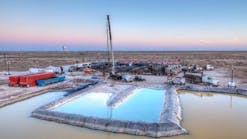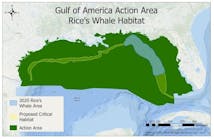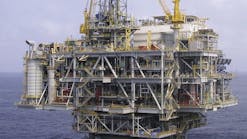Drilling and production news from the North Sea has placed the spotlight on safety, as well as innovations designed to yield more oil at less cost.
Here are the latest developments:
- U.K. operators are studying early results from experiments in modeling of offshore gas explosions, which may lead to a requirement for strengthening of some offshore installations.
- Off the U.K., BP Exploration Operating Co. Ltd. has begun oil production from Harding field using a platform made up of a jack up production unit mounted on a concrete storage base. Field partner Ranger Oil Ltd. said development cost of $3.50/bbl makes Harding one of the most economical fields in the U.K. North Sea. Ranger expects operating costs to be less than $3/bbl with full production.
- Elf Exploration U.K. plc let contracts for front end engineering design of a platform for its planned Elgin/ Franklin field development project using the same jack up concept.
In other action, BP is preparing for an extended well test in its Clair oil field in the U.K.'s West of Shetland frontier. The goal is to prove commerciality of a large, complex reservoir.
A successful test will aid in deciding on development options for Clair, particularly for a floater as in Foinaven and Schiehallion field developments, currently under way nearby, and perhaps a platform long term.
Explosion studies
Explosion tests sponsored by the U.K. Health & Safety Executive (HSE) and 10 British and Norwegian offshore operators show some methods employed to anticipate the strength of blasts may underestimate overpressure values. Hence some U.K. installations, for which the safety case includes blast resistance calculations based on methods now shown to be inaccurate, may need modifications.
British operators recently completed a 5 billion ($7.5 billion) program of upgrades to offshore installations to improve safety following an inquiry into the Piper Alpha platform blast of 1988 (OGJ, Dec. 4, 1995, p. 42).
A spokesman for the U.K. Offshore Operators Association (Ukooa) said companies are looking into the implications of new findings on offshore gas explosions, but they believe the findings are unlikely to have an effect across the board.
"We are not sure of the price tag for any work arising from this research," said the spokesman, "but operators will do whatever needs to be done."
An HSE official told Oil & Gas Journal all U.K. offshore operators were sent a letter May 7, telling them they should examine safety cases for their offshore installations to see if changes are required.
The official said, "The onus is on operators to revisit their safety cases and work out the implications of new blast analysis models. Also, we don't want operators designing new installations using some blast models."
HSE has given operators until May 31 to provide an initial response to its letter, but the official said a deadline has not been set for any upgrade work to be finished.
HSE is carrying out its own examination of safety cases and intends to compile a shortlist of installations that may need modification. HSE inspectors will visit all operators on the list within the next 3 months.
"We have a good idea of which installations will be on the shortlist," the HSE official said. "Some are older installations, particularly where congestion problems might occur and where certain blast calculation models have been used in safety cases."
However, the official said HSE's assessment has not highlighted any installation that requires an immediate shutdown. On none so far has the apparent increased risk become intolerable.
He said, "All current installations have an accepted safety case, and these cannot be rescinded. But the laws build in an obligation for reassessment under which safety cases have to be resubmitted every 3 years anyway. The first reassessments are due later this year."
The official also said only a small number of installations is likely to require upgrading in light of the new blast calculations, and these will not necessarily require major work.
A typical finding of the experiments was said to be calculation of blast overpressures for one installation, using two methods, giving a figure of 0.5 bar using one method and 4.8 bar using another.
If an operator has based the strength of blast walls on a platform using the lower figure, further strengthening may be needed in light of the higher value.
HSE said one operator that backed the research reviewed some ideas in one of its safety cases and as a result has strengthened blast walls, installed additional gas detectors, and modified deluge systems.
The research is being carried out by the Steel Construction Institute (SCI) of Ascot, U.K.. It is expected to be complete early in 1997.
HSE and SCI said early results of the experiments were made available to all operators because of their potential significance to offshore safety.
Participants in the research program are British Gas plc, BP Exploration Operating Co. Ltd., Elf Exploration U.K. plc, Enterprise Oil plc, HSE, Mobil North Sea Ltd., Norsk Hydro AS, Saga Petroleum AS, Shell U.K. Exploration & Production, Den norske stats oljeselskap AS, and Texaco Britain Ltd.
Harding jack up
Harding, in 110 m of water on Block 9/23b, holds estimated reserves of 185 million bbl of oil and 200 bcf of gas. Development cost was 430 million ($650 million).
BP began oil production at an initial rate of 5,000 b/d. This is to rise to 25,000 b/d from the first well and increase with other wells to 60,000 b/d by yearend.
The platform base was installed in June 1995. The jack up was to be installed in September 1995, but continuing bad weather delayed the operation until last January because the operation required 5 days of relative calm.
The 23,000 metric ton, heavy duty jack up can produce 64,000 b/d of oil. It is based on the TPG 500 design by Technip Geoproduction SA, Paris (OGJ, Aug. 15, 1994, p. 56).
The jack up sits on a T-shape concrete gravity base that weighs 90,000 metric tons. The base can store more than 500,000 bbl of oil, which is pumped for export to a shuttle tanker moored 2 km away.
BP said Harding's central and south reservoirs have been developed, while an estimated 15-40 million bbl of additional oil lies in satellite development prospects on the same block.
Harding's gas is reinjected into the reservoir and will be sold as oil flow wanes.
Field partners are operator BP 70%, Repsol Exploration (U.K.) Ltd. 25%, and Ranger 5%.
Elgin/Franklin
Elf let contract to McDermott Marine Construction Ltd., London, and Technip to study feasibility of using a TPG 500 design jack up as part of a central processing platform in the Elgin/Franklin development project.
McDermott and Technip, which have formed a joint venture to market the TPG 500 concept, have been given until November by Elf to complete the Elgin/Franklin study.
McDermott said, "Unique aspects of the TPG 500 design concept offer substantial savings over conventional platform installations. Key to its success is extensive use of low cost fabrication techniques, capability for full onshore commissioning, and onboard installation facilities that allow the platform to 'self-install' without heavy lift crane barges."
Elgin and Franklin gas/condensate discoveries lie in Blocks 22/30c and 29/5b, respectively. Elf plans to begin production in 2000, using a central processing complex in Elgin and a smaller platform in Franklin.
Wood Mackenzie Consultants Ltd., Edinburgh, estimates Elgin reserves at 550 bcf of gas and 125 million bbl of condensate and Franklin reserves at 700 bcf of gas and 75 million bbl of condensate.
Elf originally planned to begin production from Elgin and Franklin in 1998. However, Britain's low gas prices following gas market liberalization meant development must wait until the planned Interconnector pipeline from U.K. to Belgium affords access to a more profitable market (OGJ, Dec. 4, 1995, p. 44).
West of Shetland
The Sedco Explorer semisubmersible rig was anchoring in BP's Clair field at last report, preparing to reenter and test the 206/8-10 well, a high angle hole drilled into the core of the reservoir in 1995.
Extended well tests were planned to take place last year. BP said delays and deteriorating weather caused the well to be suspended without testing, before the onset of winter. Now BP plans a 45 day test.
"The objective of this test," BP said, "will be to try to produce about 15,000 b/d and maintain this over an extended period.
"If such production can be maintained, the partners may decide to extend the test beyond 45 days and attempt to produce as much as 2 million bbl from the reservoir, equal to three tanker cargoes."
The best Clair gauge to date is a maximum 7,300 b/d from the 206/8-9z well drilled in 1992. A second well that year flowed only 2,545 b/d maximum.
Since those tests, analysis of 3D seismic data has enabled BP geologists to map fractures in the reservoir. They have worked out which fractures can act as conduits to boost oil flow and which can restrict flow. This information was used to plot the course of the 206/8-10 well.
BP said, "If the 1996 work program is a success, the partners may decide to bring forward some form of early production scheme before the end of the century.
"Although no decisions have been taken, an early production system would help to ensure that all the commercial and geological risks are fully understood before plans for more permanent development are considered."
Clair, the first oil discovery West of Shetland, holds estimated reserves of 100-300 million bbl
of 25 o gravity oil, while oil in place is pegged at more than 4 billion bbl (OGJ, June 20, 1994, p. 16).
Clair lies in Blocks 206/7a, 206/8, 206/9, 206/12, and 206/13, where maximum water depth is 150 m. Since its discovery in 1977, ten appraisal wells have been drilled, but none has flowed enough oil to make development viable.
Copyright 1996 Oil & Gas Journal. All Rights Reserved.


